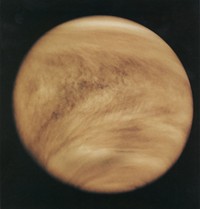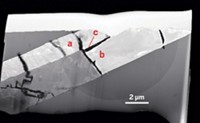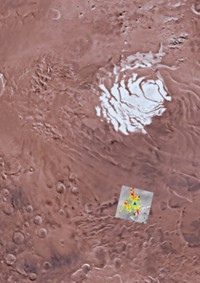Advertisement
Grab your lab coat. Let's get started
Welcome!
Welcome!
Create an account below to get 6 C&EN articles per month, receive newsletters and more - all free.
It seems this is your first time logging in online. Please enter the following information to continue.
As an ACS member you automatically get access to this site. All we need is few more details to create your reading experience.
Not you? Sign in with a different account.
Not you? Sign in with a different account.
ERROR 1
ERROR 1
ERROR 2
ERROR 2
ERROR 2
ERROR 2
ERROR 2
Password and Confirm password must match.
If you have an ACS member number, please enter it here so we can link this account to your membership. (optional)
ERROR 2
ACS values your privacy. By submitting your information, you are gaining access to C&EN and subscribing to our weekly newsletter. We use the information you provide to make your reading experience better, and we will never sell your data to third party members.
Astrochemistry
Cold brines under Mars’s surface could hold a lot of oxygen
Theoretical calculations have implications for search for life on the planet and understanding its geochemistry
by Sam Lemonick
October 26, 2018

New calculations suggest cold brines theorized to exist below Mars’ surface could hold enough oxygen to sustain some kinds of life seen on Earth (Nat. Geosci. 2018, DOI: 10.1038/s41561-018-0243-0). But some experts suggest caution in interpreting these data as a strong case for conditions that could support life on the red planet. And others note that the findings may help explain some Martian geochemistry that has puzzled researchers.
Now calculations from Vlada Stamenković of California Institute of Technology and colleagues show that cold brines near the planet’s surface could sport oxygen concentrations as high as 1 mol/m3 at 140 K, enough oxygen to theoretically support aerobic life.

Stamenković acknowledges one major assumption the team made in their calculations: Cold brines exist under Mars’s surface. There is no direct evidence for their presence, although radar research has identified likely liquids more than a kilometer under Mars’ southern pole (Science 2018, DOI: 10.1126/science.aar7268). Scientists also recently identified hydrated magnesium and calcium perchlorate salts at or near Mars’ surface, indicating brines of those molecules might exist. With enough salt, such brines could remain liquid below their freezing point—a phenomenon known as supercooling—down to temperatures around the 140 K used in the new calculations. While higher concentrations of salt in water generally translate to lower oxygen solubility, the solubility can increase at the low temperatures observed on Mars. The group weighed all of these factors in their thermodynamic calculations.
Stamenković says this work suggests the brines could exist, and hold enough oxygen for some organisms. “Am I comfortable saying there is life on Mars? I have no clue whether there ever was or is life on Mars,” Stamenković says. He says his group felt it was important to publish these results because, until now, scientists thought there was almost no available oxygen on Mars.
Drawing a link between oxygen solubility in brines and the possibility of life on Mars gives some scientists pause. Life requires a lot of different factors, and “oxygen is only maybe one of them,” says Jonathan Toner of the University of Washington, who studies the habitability of cold, salty environments on Earth and other bodies in the Solar System. Toner says his own calculations confirm the Caltech team’s. But he points out that supercooled liquids like these proposed brines may exist only for hours at a time before they freeze, which would likely kill any organisms in them. And even if the brines remained liquid, Toner and others argue that Mars’s low temperatures could present a problem for organisms, preventing them from metabolizing nutrients or reproducing. Toner also points out that ions would cling tightly to water molecules in these brines, potentially limiting access to another ingredient we think of as necessary to life.
Andrew Martin, a sea ice microbial physiologist at the University of Tasmania, agrees it’s too early to imagine microbes living in these brines. He says what’s useful about this research is it gives scientists well-defined conditions to test these predictions in the lab, something Stamenković says his team has been attempting.
Advertisement
In the new paper, the researchers also briefly mention another implication for their calculations: The oxygenated brines could play a role in Martian chemical weathering. Mars’s surface is red due to an abundance of iron oxide. The existence of other recently discovered oxide minerals, like manganese oxide, require an oxidizer that we haven’t yet identified, says Nina Lanza, a planetary geologist at Los Alamos National Laboratory. On Earth, Lanza says, manganese oxide minerals didn’t form until after photosynthesizing organisms sharply increased the amount of atmospheric oxygen. She says the brines described by the Caltech team could provide a mechanism for making these manganese oxides.
Everyone agrees that more research—including lab experiments on Earth and observations on Mars—is needed to learn more about whether and where these brines exist and what they contain.





Join the conversation
Contact the reporter
Submit a Letter to the Editor for publication
Engage with us on Twitter